Chaotic Synchronizing Systems with Zero Time Delay and Free Couple via Iterative Learning Control
Abstract
:1. Introduction
2. The Iterative Learning Control (ILC) Problem Formulation
2.1. System Description
- (a)
- When is the Lyapunov function of an estimation system in the system (Equation (3)).
- (b)
- Ifis Lyapunov function of the system (Equation (2)), then the system should bestable.
2.2. Proposed Algorithm for Iterative Learning Control Law
3. Example Illustration and Demonstrated Results
3.1. The Example of Iterative Learning Algorithmto Decide Learning Law
3.2. Simulation Results and Discussion
4. Conclusions
Author Contributions
Conflicts of Interest
References
- Arimoto, S.; Kawamura, S.; Miyazaki, F. Bettering Operation of Robots by Learning. J. Robot. Syst. 1984, 1, 123–140. [Google Scholar] [CrossRef]
- Moore, K.L. Iterative Learning Control for Deterministic System; Springer: New York, NY, USA, 1992; pp. 9–45. ISBN 3-540-19707-9. [Google Scholar]
- Bristow, D.A.; Tharayil, M.; Alleyne, A.G. A Survey of Iterative Learning Control. IEEE Control Syst. 2006, 26, 96–114. [Google Scholar] [CrossRef]
- María, T.R.; Banks, S.P. Linear, Time-Varying Approximations to Nonlinear Dynamical Systems; Springer: Berlin, Germany, 2010; pp. 11–28. [Google Scholar]
- Acho, L. A Chaotic Secure Communication System Design Based on Iterative Learning Control Theory. Appl. Sci. 2016, 6, 311. [Google Scholar] [CrossRef]
- Kinzel, W.; Englert, A.; Kanter, I. On chaos synchronization and secure communication. Philos. Trans. R. Soc. A 2010, 368, 379–389. [Google Scholar] [CrossRef] [PubMed]
- Madady, A. An Extended PID Type Iterative Learning Control. Int. J. Control Autom. Syst. 2013, 11, 470–481. [Google Scholar] [CrossRef]
- Kuc, T.Y.; Lee, J.S.; Nam, K. An Iterative Learning Control for a Class of Nonlinear Dynamic Systems. Automatica 1992, 28, 1215–1221. [Google Scholar] [CrossRef]
- Helfrich, B.E.; Lee, C.; Bristow, D.A.; Salapaka, S.M.; Ferreira, P.M. Combined H-infinity-Feedback control and Iterative Learning Control Design with Application to Nanopositioning Systems. IEEE Trans. Control Syst. Technol. 2010, 18, 336–351. [Google Scholar] [CrossRef]
- Liu, Z.; Wang, J.; Deng, B.; Wei, X.; Yu, H. Synchronization of Ghostburster neuron via Iterative Learning Contol. In Proceedings of the 2014 7thIEEE International Conference on Biomedical Engineering and Informatics (BMEI), Dalian, China, 14–16 October 2014; pp. 472–477. [Google Scholar]
- Xu, J.X.; Yan, R.; Chen, Y.Q. On initial Conditions in Iterative Learning Control. IEEE Trans. Autom. Control 2005, 50, 1349–1354. [Google Scholar]
- Cheng, C.K.; Kuo, H.H.; Hou, Y.Y.; Hwang, C.C.; Liao, T.L. Robust chaos synchronization of noise-perturbed chaotic systems with multiple time delay. Phys. A Stat. Mech. Appl. 2008, 387, 3093–3102. [Google Scholar] [CrossRef]
- Hauser, J.E. Learning control for a class of nonlinear systems. In Proceedings of the 26th IEEE Conference on Decision and Control, Los Angeles, CA, USA; 1987. [Google Scholar] [CrossRef]
- Zhou, S.; Li, H.; Wu, Z. Synchronization threshold of a coupled time-delay system. Phys. Rev. E 2007, 75, 037203. [Google Scholar] [CrossRef] [PubMed]
- Chen, M.; Kurths, J. Synchronization of time-delayed systems. Phys. Rev. E 2007, 76, 036212. [Google Scholar] [CrossRef] [PubMed]
- Shahverdiev, E.M. Synchronization in systems with multiple time delays. Phys. Rev. E 2004, 70, 067202. [Google Scholar] [CrossRef] [PubMed]
- Shahverdiev, E.M.; Shore, K.A. Generalized synchronization in time-delayed systems. Phys. Rev. E 2005, 71, 016201. [Google Scholar] [CrossRef] [PubMed]
- Voss, H.U. Anticipating chaotic synchronization. Phys. Rev. E 2000, 61, 5115–5119. [Google Scholar] [CrossRef]
- Pyragas, K. Synchronization of coupled time-delay systems: Analytical estimations. Phys. Rev. E 1998, 58, 3067–3071. [Google Scholar] [CrossRef]
- Lia, C.; Chen, G. Synchronization in general complex dynamical networks with coupling delays. Phys. A Stat. Mech. Appl. 2004, 343, 263–278. [Google Scholar] [CrossRef]
- Saridis, G.N. Stochastic Processes Estimation and Control: The Entropy Approach; John Wiley & Sons, Inc.: New York, NY, USA, 1995; pp. 365–371. ISBN 0-471-09756-X. [Google Scholar]
- Wu, X.F.; Chen, G.R.; Cai, J.P. Chaos synchronization of the master-slave generalized Lorenz systems via linear state error feedback control. Phys. D Nonlinear Phenom. 2007, 229, 52–80. [Google Scholar] [CrossRef]
- Kim, J.; Jin, M. Synchronization of chaotic systems using particle swarm optimization and time-delay estimation. Nonlinear Dyn. 2016, 86, 2003–2015. [Google Scholar] [CrossRef]
- Englert, A.; Heiligenthal, S.; Kinzel, W.; Kanter, I. Synchronization of chaotic networks with time-delayed couplings: An analytic study. Phys. Rev. E. 2011, 83, 046222. [Google Scholar] [CrossRef] [PubMed]
- Hjalmarsson, H. Iterative feedback tuning-an overview. Int. J. Adapt. Control Signal Process. 2002, 16, 373–395. [Google Scholar] [CrossRef]
- Hjalmarsson, H.; Gevers, M.; Gunnarsson, S.; Lequin, O. Iterative feedback tuning: Theory and applications. IEEE Control Syst. 1998, 18, 26–40. [Google Scholar] [CrossRef]
- Lorenz, E.N. Deterministic Nonperiodic Flow. J. Atmos. Sci. 1963, 20, 130–142. [Google Scholar] [CrossRef]
- Cheng, C.K.; Chao, P.C.-P. Chaotic Synchronizing Systems via Iterative Learning Control. In Proceedings of the IEEE international conference on Applied System Innovation, New Sapporo City, Japan, 15–20 May 2017. [Google Scholar]
- Lü, J.; Zhou, T.; Zhang, S. Chaos Synchronization between Linearly Coupled Chaotic Systems. Chaos Solitons Fractal 2002, 14, 529–541. [Google Scholar] [CrossRef]
- Zelinka, I.; Chadli, M.; Davendra, D.; Senkerik, R.; Jasek, R. An investigation on evolutionary reconstruction of continuous chaoticsystems. Math. Comput. Model. 2013, 57, 2–15. [Google Scholar] [CrossRef]
- Chadli, M.; Zelinka, I. Chaos synchronization of unknown inputs Takagi–Sugeno fuzzy: Application to secure communications. Comput. Math. Appl. 2014, 68, 2142–2147. [Google Scholar] [CrossRef]
- Chadli, M.; Zelinka, I.; Youssef, T. Unknown inputs observer design for fuzzy systems with application tochaotic system reconstruction. Comput. Math. Appl. 2013, 66, 147–154. [Google Scholar] [CrossRef]
- Zhang, W.; Gui, Z.; Wang, K. Impulsive Control for Synchronization of Lorenz Chaotic System. J. Softw. Eng. Appl. Sci. Res. 2012, 5, 23–25. [Google Scholar] [CrossRef]
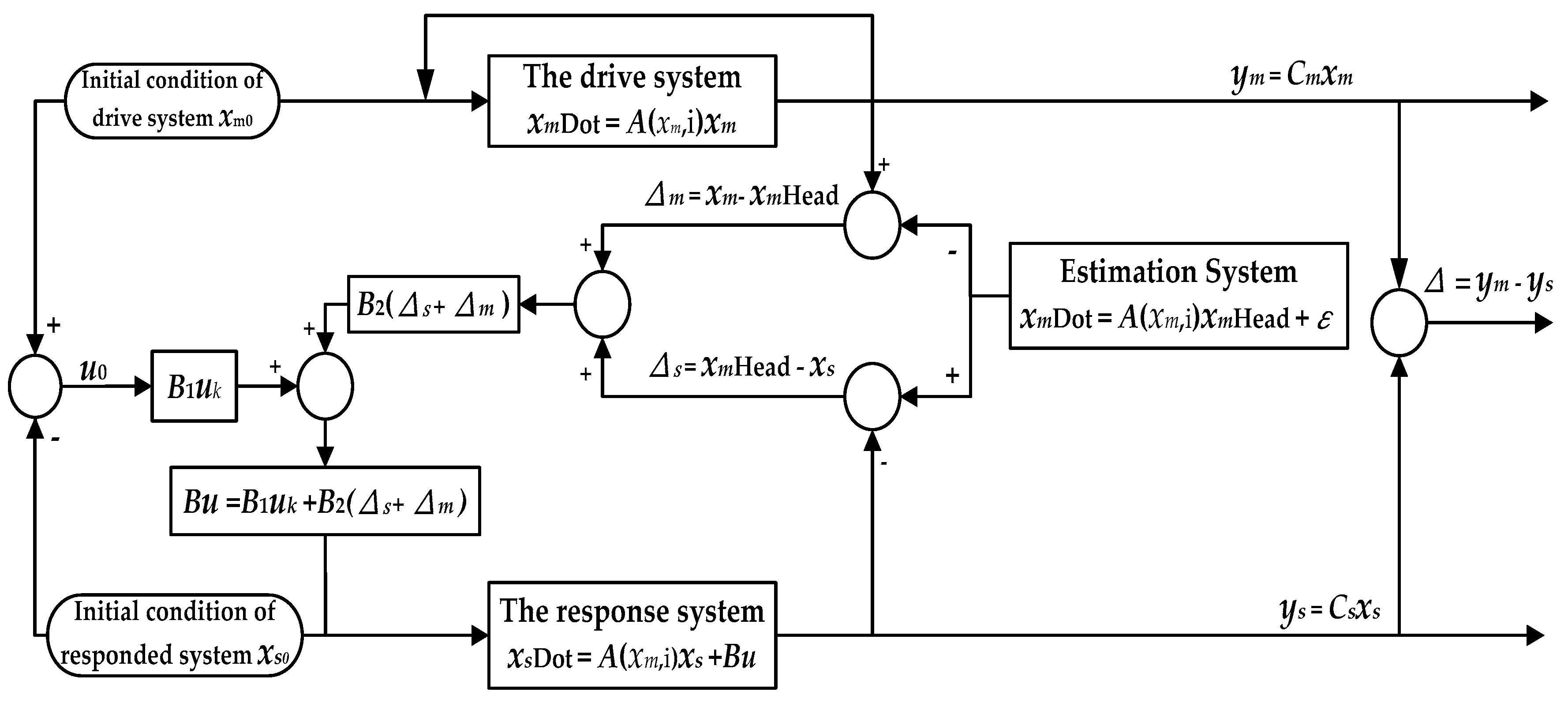
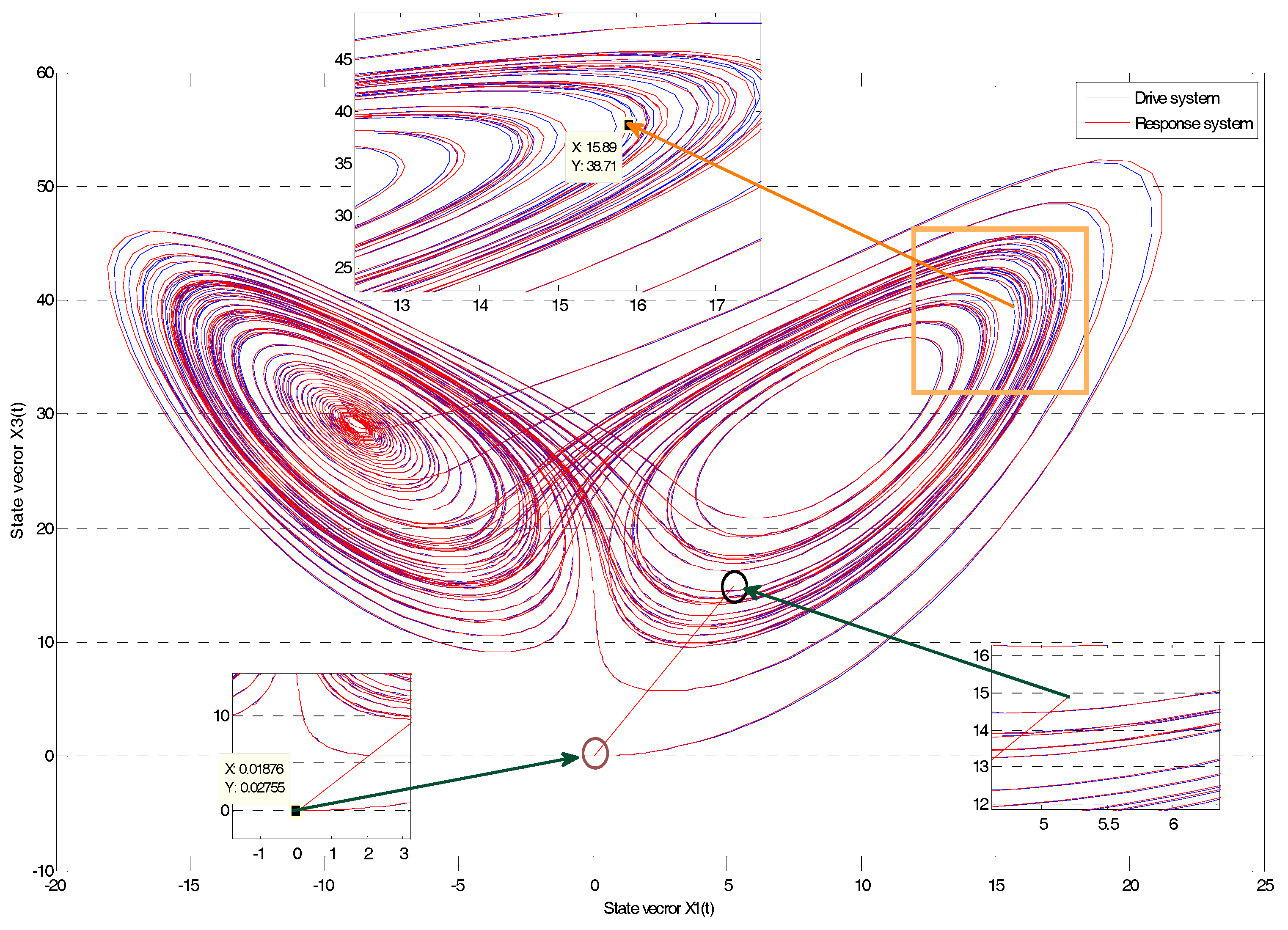
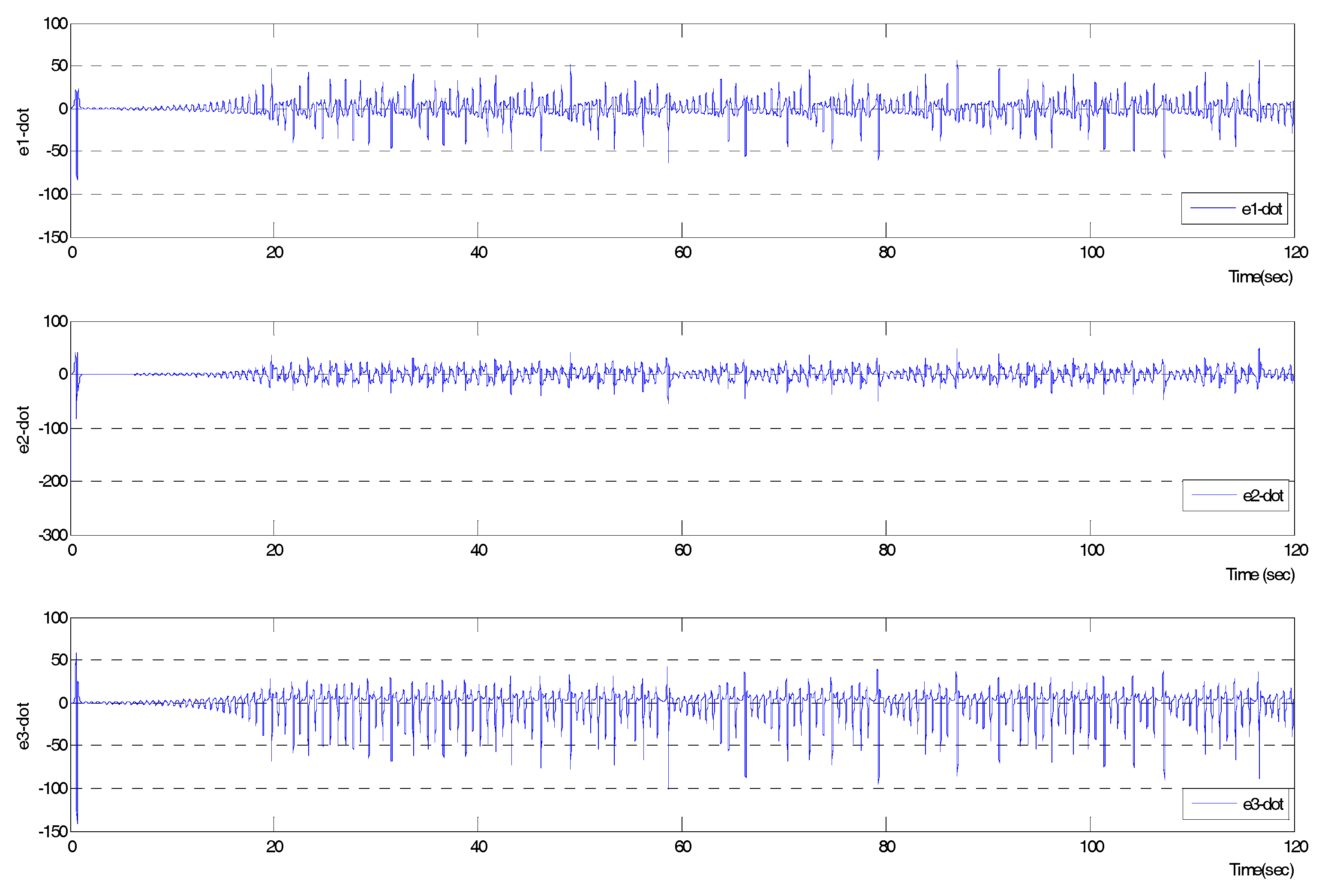
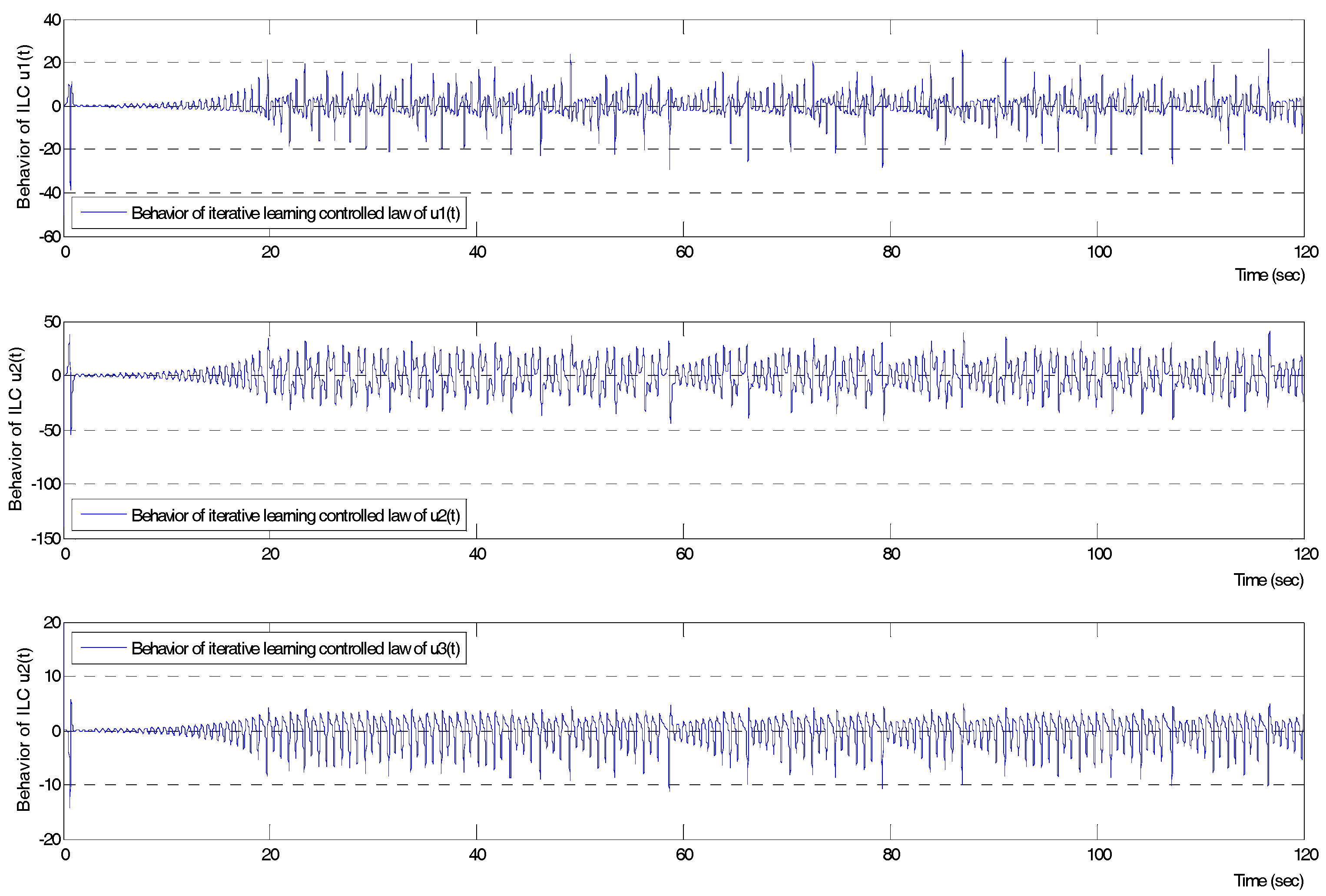
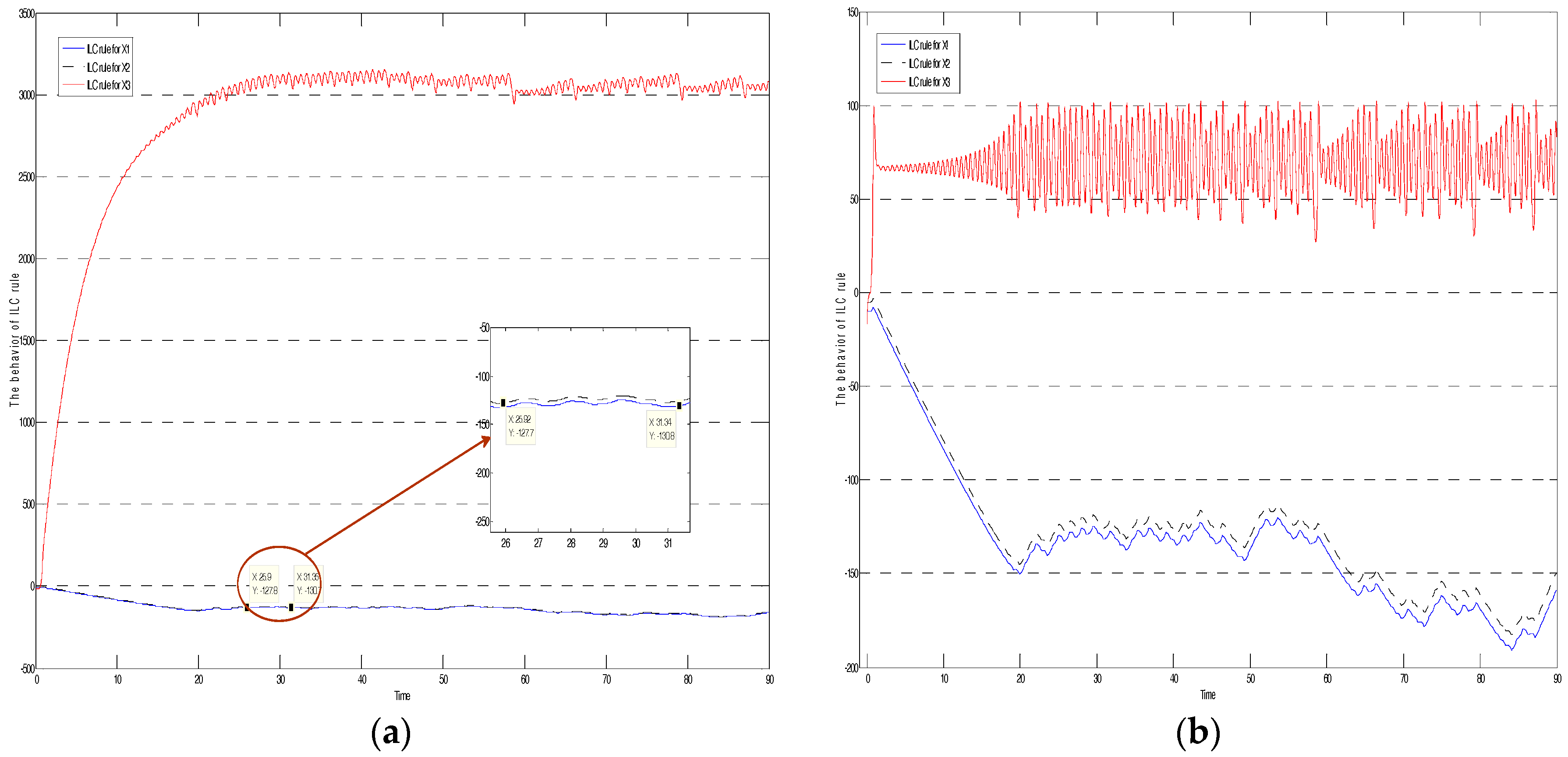



| Value of μ | [−1, 1] | (−∞, −1] | [1, ∞] | Total | Average |
|---|---|---|---|---|---|
| 1 | 1945 | 4811 | 5345 | 12001 | −2.5314 |
| 10 | 396 | 5473 | 6132 | 12001 | –19.896 |
| 50 | 93 | 5623 | 6285 | 12001 | –97.0546 |
| –10 | 393 | 6149 | 5459 | 12001 | 18.635 |
© 2018 by the authors. Licensee MDPI, Basel, Switzerland. This article is an open access article distributed under the terms and conditions of the Creative Commons Attribution (CC BY) license (http://creativecommons.org/licenses/by/4.0/).
Share and Cite
Cheng, C.-K.; Chao, P.C.-P. Chaotic Synchronizing Systems with Zero Time Delay and Free Couple via Iterative Learning Control. Appl. Sci. 2018, 8, 177. https://doi.org/10.3390/app8020177
Cheng C-K, Chao PC-P. Chaotic Synchronizing Systems with Zero Time Delay and Free Couple via Iterative Learning Control. Applied Sciences. 2018; 8(2):177. https://doi.org/10.3390/app8020177
Chicago/Turabian StyleCheng, Chun-Kai, and Paul C. -P. Chao. 2018. "Chaotic Synchronizing Systems with Zero Time Delay and Free Couple via Iterative Learning Control" Applied Sciences 8, no. 2: 177. https://doi.org/10.3390/app8020177





